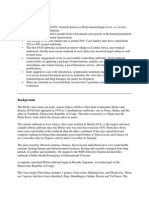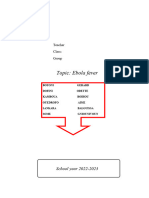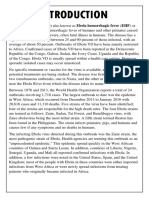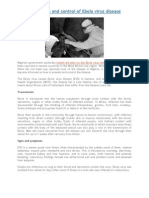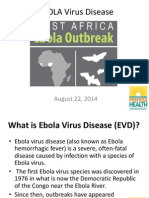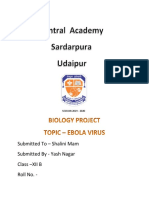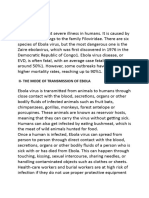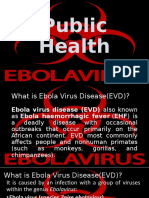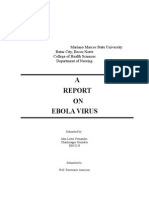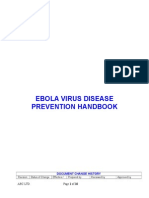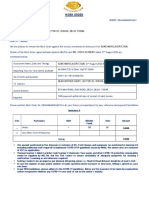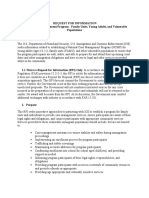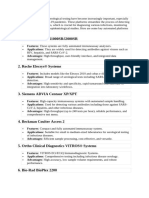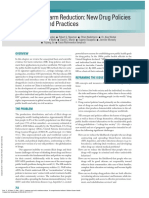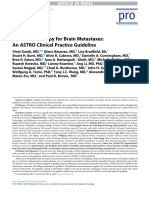0 ratings0% found this document useful (0 votes)
20 viewsEbola Hemorrhagic Fever: Transmission
Ebola Hemorrhagic Fever: Transmission
Uploaded by
romeoenny4154Ebola hemorrhagic fever is a severe and often fatal disease caused by infection with one of five Ebolavirus species. Symptoms include fever, headache, muscle pain and bleeding both internally and externally. It spreads through direct contact with body fluids of infected people or contaminated surfaces. While the natural host is unknown, fruit bats are suspected. There is no approved vaccine or treatment, though experimental treatments have shown promise in animal studies.
Copyright:
© All Rights Reserved
Available Formats
Download as PDF, TXT or read online from Scribd
Ebola Hemorrhagic Fever: Transmission
Ebola Hemorrhagic Fever: Transmission
Uploaded by
romeoenny41540 ratings0% found this document useful (0 votes)
20 views3 pagesEbola hemorrhagic fever is a severe and often fatal disease caused by infection with one of five Ebolavirus species. Symptoms include fever, headache, muscle pain and bleeding both internally and externally. It spreads through direct contact with body fluids of infected people or contaminated surfaces. While the natural host is unknown, fruit bats are suspected. There is no approved vaccine or treatment, though experimental treatments have shown promise in animal studies.
Original Title
Ebola Factsheet
Copyright
© © All Rights Reserved
Available Formats
PDF, TXT or read online from Scribd
Share this document
Did you find this document useful?
Is this content inappropriate?
Ebola hemorrhagic fever is a severe and often fatal disease caused by infection with one of five Ebolavirus species. Symptoms include fever, headache, muscle pain and bleeding both internally and externally. It spreads through direct contact with body fluids of infected people or contaminated surfaces. While the natural host is unknown, fruit bats are suspected. There is no approved vaccine or treatment, though experimental treatments have shown promise in animal studies.
Copyright:
© All Rights Reserved
Available Formats
Download as PDF, TXT or read online from Scribd
Download as pdf or txt
0 ratings0% found this document useful (0 votes)
20 views3 pagesEbola Hemorrhagic Fever: Transmission
Ebola Hemorrhagic Fever: Transmission
Uploaded by
romeoenny4154Ebola hemorrhagic fever is a severe and often fatal disease caused by infection with one of five Ebolavirus species. Symptoms include fever, headache, muscle pain and bleeding both internally and externally. It spreads through direct contact with body fluids of infected people or contaminated surfaces. While the natural host is unknown, fruit bats are suspected. There is no approved vaccine or treatment, though experimental treatments have shown promise in animal studies.
Copyright:
© All Rights Reserved
Available Formats
Download as PDF, TXT or read online from Scribd
Download as pdf or txt
You are on page 1of 3
Ebol a Hemorrhagi c Fever
National Center for Emerging and Zoonotic Infectious Diseases
Division of High-Consequence Pathogens and Pathology (DHCPP)
Ebola hemorrhagic fever (Ebola HF) is one of numerous Viral Hemorrhagic Fevers. It is a severe, often fatal disease in
humans and nonhuman primates (such as monkeys, gorillas, and chimpanzees).
Ebola HF is caused by infection with a virus of the family Filoviridae, genus Ebolavirus. When infection occurs, symptoms
usually begin abruptly. The first Ebolavirus species was discovered in 1976 in what is now the Democratic Republic of the
Congo near the Ebola River. Since then, outbreaks have appeared sporadically.
There are five identified subspecies of Ebolavirus. Four of the five have caused disease in humans: Ebola virus (Zaire
ebolavirus); Sudan virus (Sudan ebolavirus); Ta Forest virus (Ta Forest ebolavirus, formerly Cte dIvoire ebolavirus); and
Bundibugyo virus (Bundibugyo ebolavirus). The fifth, Reston virus (Reston ebolavirus), has caused disease in nonhuman
primates, but not in humans.
The natural reservoir host of ebolaviruses remains unknown. However, on the basis of available evidence and the nature of
similar viruses, researchers believe that the virus is zoonotic (animal-borne) with bats being the most likely reservoir. Four of
the five subtypes occur in an animal host native to Africa.
A host of similar species is probably associated with Reston virus, which was isolated from infected cynomolgous monkeys
imported to the United States and Italy from the Philippines. Several workers in the Philippines and in US holding facility
outbreaks became infected with the virus, but did not become ill.
Transmission
Because the natural reservoir of ebolaviruses has not yet been proven, the manner in which the virus first appears in a
human at the start of an outbreak is unknown. However, researchers have hypothesized that the first patient becomes
infected through contact with an infected animal.
When an infection does occur in humans, there are several ways in which the virus can be transmitted to others. These
include:
direct contact with the blood or secretions of an infected person
exposure to objects (such as needles) that have been contaminated with infected secretions
The viruses that cause Ebola HF are often spread through families and friends because they come in close contact with
infectious secretions when caring for ill persons.
During outbreaks of Ebola HF, the disease can spread quickly within health care settings (such as a clinic or hospital).
Exposure to ebolaviruses can occur in health care settings where hospital staff are not wearing appropriate protective
equipment, such as masks, gowns, and gloves.
Proper cleaning and disposal of instruments, such as needles and syringes, is also important. If instruments are not
disposable, they must be sterilized before being used again. Without adequate sterilization of the instruments, virus
transmission can continue and amplify an outbreak.
Signs and Symptoms
Symptoms of Ebola HF typicall y incl ude: Some patients may experience:
Fever
Headache
Joint and muscle aches
Weakness
Diarrhea
Vomiting
Stomach pain
Lack of appetite
A Rash
Red Eyes
Hiccups
Cough
Sore throat
Chest pain
Difficulty breathing
Difficulty swallowing
Bleeding inside and outside of the body
Symptoms may appear anywhere from 2 to 21 days after exposure to ebolavirus though 8-10 days is most common.
Some who become sick with Ebola HF are able to recover, while others do not. The reasons behind this are not yet fully
understood. However, it is known that patients who die usually have not developed a significant immune response to the
virus at the time of death.
Risk of Exposure
In Africa, confirmed cases of Ebola HF have been reported in:
Democratic Republic of the Congo (DRC)
Gabon
South Sudan
Ivory Coast
Uganda
Republic of the Congo (ROC)
South Africa (imported)
The natural reservoir host of ebolaviruses, and the manner in which transmission of the virus to humans occurs, remain
unknown. This makes risk assessment in endemic areas difficult. Currently, all cases of illness or death have occurred in
Africa; no case has been reported in the United States.
During outbreaks of Ebola HF, those at highest risk include health care workers and the family and friends of an infected
individual. Health care workers in Africa should consult the Infection Control for Viral Hemorrhagic Fevers In the African
Health Care Setting to learn how to prevent and control infections in these setting. Medical professionals in the United States
should consult the Interim Guidance for Managing Patients with Suspected Viral Hemorrhagic Fever in U.S. Hospitals.
Diagnosis
Diagnosing Ebola HF in an individual who has been infected for only a few days is difficult, because the early symptoms,
such as red eyes and a skin rash, are nonspecific to ebolavirus infection and are seen often in patients with more commonly
occurring diseases.
However, if a person has the early symptoms of Ebola HF and there is reason to believe that Ebola HF should be
considered, the patient should be isolated and public health professionals notified. Samples from the patient can then be
collected and tested to confirm infection.
Laboratory tests used in diagnosis include:
Timeline of Infection Diagnostic tests available
Within a few days after symptoms begin
-
Antigen-capture enzyme-linked immunosorbent assay
(ELISA) testing
- IgM ELISA
- Polymerase chain reaction (PCR)
- Virus isolation
Later in disease course or after recovery
-
IgM and IgG antibodies
Retrospectively in deceased patients
-
Immunohistochemistry testing
- PCR
- Virus isolation
Sierra Leone
Liberia
Guinea
However, if a person has the early symptoms of Ebola HF and there is reason to believe that Ebola HF should be
considered, the patient should be isolated and public health professionals notified. Supportive therapy can continue with
proper protective clothing until samples from the patient are tested to confirm infection.
Experimental treatment has been tested and proven effective in animal models but has not yet been used in humans.
Prevention
The prevention of Ebola HF presents many challenges. Because it is still unknown how exactly people are infected with
Ebola HF, there are few established primary prevention measures.
When cases of the disease do appear, there is increased risk of transmission within health care settings. Therefore, health
care workers must be able to recognize a case of Ebola HF and be ready to employ practical viral hemorrhagic fever
isolation precautions or barrier nursing techniques. They should also have the capability to request diagnostic tests or
prepare samples for shipping and testing elsewhere.
Barrier nursing techniques include:
wearing of protective clothing (such as masks, gloves, gowns, and goggles)
the use of infection-control measures (such as complete equipment sterilization and routine use of disinfectant)
isolation of Ebola HF patients from contact with unprotected persons
The aim of all of these techniques is to avoid contact with the blood or secretions of an infected patient. If a patient with
Ebola HF dies, it is equally important that direct contact with the body of the deceased patient be prevented.
CDC, in conjunction with the World Health Organization, has developed a set of guidelines to help prevent and control the
spread of Ebola HF. Entitled Infection Control for Viral Hemorrhagic Fevers In the African Health Care Setting, the manual
describes how to:
recognize cases of viral hemorrhagic fever (such as Ebola HF)
prevent further transmission in health care setting by using locally available materials and minimal financial
resources
Treatment
Standard treatment for Ebola HF is still limited to supportive therapy. This consists of:
balancing the patients fluids and electrolytes
maintaining their oxygen status and blood pressure
treating them for any complicating infections
Timely treatment of Ebola HF is important but challenging since the disease is difficult to diagnose clinically in the early
stages of infection. Because early symptoms such as headache and fever are nonspecific to ebolaviruses, cases of Ebola
HF may be initially misdiagnosed.
You might also like
- MBC 7dayguide WrecipesDocument30 pagesMBC 7dayguide Wrecipesbernard.hollamby1794% (16)
- EBOLADocument4 pagesEBOLAwawa3385No ratings yet
- Ebola FactsheetDocument3 pagesEbola FactsheetJohn Rey AbadNo ratings yet
- About Ebola Hemorrhagic FeverDocument5 pagesAbout Ebola Hemorrhagic FeverMiryam ChNo ratings yet
- CDC Ebola Fact SheetDocument13 pagesCDC Ebola Fact Sheetيوسف سيمنزNo ratings yet
- Ebola Virus DiseaseDocument4 pagesEbola Virus Diseasev_vijayakanth7656No ratings yet
- Ebola Virus Disease (EVD) : What Are The Symptoms?Document2 pagesEbola Virus Disease (EVD) : What Are The Symptoms?Travel Health FremantleNo ratings yet
- ebola researchDocument35 pagesebola researchMɽ PèŗfècţNo ratings yet
- PHE Information On Ebola in Pregnancy V2 0Document4 pagesPHE Information On Ebola in Pregnancy V2 0Philip ScofieldNo ratings yet
- Ebola Virus Disease: Key FactsDocument3 pagesEbola Virus Disease: Key FactsAnthony Miguel RafananNo ratings yet
- Ebola Virus Disease: Key FactsDocument5 pagesEbola Virus Disease: Key FactsMichaelKimDugeniaNo ratings yet
- Ebola (Ebola Virus Disease) : TransmissionDocument2 pagesEbola (Ebola Virus Disease) : TransmissionCaleb VoosNo ratings yet
- Ebola Virus Disease: Key FactsDocument5 pagesEbola Virus Disease: Key Facts黄銮添No ratings yet
- Key FactsDocument4 pagesKey FactsAnonymous JOOQkGbwoRNo ratings yet
- Ebola Virus Generic Information SheetDocument3 pagesEbola Virus Generic Information SheetdinnetteformeNo ratings yet
- Ebola Virus DiseaseDocument3 pagesEbola Virus DiseasePoonam RanaNo ratings yet
- Ebola Virus DiseaseDocument6 pagesEbola Virus DiseaseDyan LazoNo ratings yet
- EbolaDocument20 pagesEbolaFabian PitkinNo ratings yet
- History: Ebolavirus. After This Discovery, Scientists Concluded That The Virus Came From Two DifferentDocument4 pagesHistory: Ebolavirus. After This Discovery, Scientists Concluded That The Virus Came From Two DifferentAsniah Hadjiadatu AbdullahNo ratings yet
- Ebola Frequently Asked Questions: 818 E. Broadway Sparta, Il 62286 618-443-2177Document2 pagesEbola Frequently Asked Questions: 818 E. Broadway Sparta, Il 62286 618-443-2177Maria Chacón CarbajalNo ratings yet
- 1) Crimean-Congo Hemorrhagic Fever (CCHF) : DiagnosisDocument55 pages1) Crimean-Congo Hemorrhagic Fever (CCHF) : DiagnosisKaish DahiyaNo ratings yet
- Ebola Overview TemplateDocument35 pagesEbola Overview TemplateNoneyaNo ratings yet
- EbolaDocument3 pagesEbolaupasana.b.1012No ratings yet
- Transmicion: FiloviridaeDocument15 pagesTransmicion: FiloviridaeDaniela Ortiz100% (1)
- Ebola EbvDocument5 pagesEbola EbvAmal Bahrum PenasNo ratings yet
- Understanding Ebola VirusDocument2 pagesUnderstanding Ebola VirusChellaMarieNo ratings yet
- Ebola: What Clinicians Need To KnowDocument3 pagesEbola: What Clinicians Need To KnowIman100% (1)
- Ebola Health Education CHNDocument23 pagesEbola Health Education CHNBrijesh YadavNo ratings yet
- Ebola Virus Disease: Key FactsDocument2 pagesEbola Virus Disease: Key FactsNi-el 'ndra' SantosoNo ratings yet
- EBOLADocument6 pagesEBOLAraodatstdtechnologie100% (1)
- EbolaDocument2 pagesEbolaAnnabelle WinterNo ratings yet
- Health DepartmentDocument14 pagesHealth DepartmentnadiaNo ratings yet
- Ebola Virus Disease Grassroots Talking PointsDocument4 pagesEbola Virus Disease Grassroots Talking PointsMargaretWilsonNo ratings yet
- EbolaDocument3 pagesEbolaankeritenursing 647No ratings yet
- Ebola Virus DiseaseDocument17 pagesEbola Virus DiseaseNgetwa Wiryboy stNo ratings yet
- Choo Choy Tian 00000027562 CH219 Practical ReportDocument6 pagesChoo Choy Tian 00000027562 CH219 Practical ReportWei Hao ChanNo ratings yet
- Bahasa Inggris 1Document41 pagesBahasa Inggris 1RizqyAuliaNestaNo ratings yet
- Ebola Infectious Disease Viral InfectionDocument10 pagesEbola Infectious Disease Viral Infectionmutimut chNo ratings yet
- Class 12 CBSE Investigatory Project On EbolaDocument19 pagesClass 12 CBSE Investigatory Project On EbolaAdriana Dkhar Toi56% (9)
- Hkaro - PeroDocument5 pagesHkaro - PeroDANA S. SALIMNo ratings yet
- Prevention and Control of Ebola Virus DiseaseDocument3 pagesPrevention and Control of Ebola Virus DiseasenzeprimeNo ratings yet
- North South University: Submitted ToDocument13 pagesNorth South University: Submitted ToProbir Saha (192051023)No ratings yet
- WHO - Ebola Virus DiseaseDocument6 pagesWHO - Ebola Virus Diseasedhoo_babyNo ratings yet
- Ebola VirusDocument14 pagesEbola VirusLinto JohnNo ratings yet
- Biology Ebola Virus Project ReportDocument19 pagesBiology Ebola Virus Project ReportChaitaneyMorNo ratings yet
- Ebola Factsheet PDocument2 pagesEbola Factsheet PBlessyren AtmaNo ratings yet
- Ebola Virus 2Document17 pagesEbola Virus 2Rashid madniNo ratings yet
- Submitted To - Shalini Mam Submitted by - Yash Nagar Class - XII B Roll No.Document10 pagesSubmitted To - Shalini Mam Submitted by - Yash Nagar Class - XII B Roll No.Yash Nagar100% (1)
- Ebola Virus Disease: FiloviridaeDocument4 pagesEbola Virus Disease: FiloviridaeJbl2328No ratings yet
- Bio Project Class 12Document15 pagesBio Project Class 12joyitaNo ratings yet
- I-What Is Ebola ?Document4 pagesI-What Is Ebola ?ndakamlanemmanuelNo ratings yet
- Ebola RPRTDocument19 pagesEbola RPRTDel FinNo ratings yet
- Ebola Virnzddfus: Prepared by BLACK Professor: NB Year: 2019-2020 Subject: HDFHDFHDDocument5 pagesEbola Virnzddfus: Prepared by BLACK Professor: NB Year: 2019-2020 Subject: HDFHDFHDDANA S. SALIMNo ratings yet
- Ebola Virnzddfus: Prepared by BLACK Professor: NB Year: 2019-2020 Subject: HDFHDFHDDocument5 pagesEbola Virnzddfus: Prepared by BLACK Professor: NB Year: 2019-2020 Subject: HDFHDFHDDANA S. SALIMNo ratings yet
- Ebola Virnzddfus: Prepared by BLACK Professor: NB Year: 2019-2020 Subject: HDFHDFHDDocument5 pagesEbola Virnzddfus: Prepared by BLACK Professor: NB Year: 2019-2020 Subject: HDFHDFHDDANA S. SALIMNo ratings yet
- On Recent Diseases - EbolaDocument7 pagesOn Recent Diseases - EbolaM.NandabalanNo ratings yet
- Ebola VirusDocument12 pagesEbola VirusJohn Lester FernandezNo ratings yet
- Ebola Virus Patient Advisory 181014Document7 pagesEbola Virus Patient Advisory 181014eblackhole1No ratings yet
- ABC LTD Ebola Prevention HandbookDocument10 pagesABC LTD Ebola Prevention HandbookAcholonu Emeka JpNo ratings yet
- Ebola Outbreak: How to Survive and Protect Your FamilyFrom EverandEbola Outbreak: How to Survive and Protect Your FamilyRating: 2.5 out of 5 stars2.5/5 (3)
- Ebola Outbreak Survival Guide 2015: 5 Key Things You Need To Know About The Ebola Pandemic & Top 3 Preppers Survival Techniques They Don’t Want You To KnowFrom EverandEbola Outbreak Survival Guide 2015: 5 Key Things You Need To Know About The Ebola Pandemic & Top 3 Preppers Survival Techniques They Don’t Want You To KnowNo ratings yet
- Febrile Neonate Clinical Practice Guideline: CatheterizedDocument1 pageFebrile Neonate Clinical Practice Guideline: Catheterizedromeoenny4154No ratings yet
- 51 Allergens Set: Sr. No. Patch Test Allergen Price (RS.)Document2 pages51 Allergens Set: Sr. No. Patch Test Allergen Price (RS.)romeoenny4154No ratings yet
- Congenital Heart Disease 2014Document1 pageCongenital Heart Disease 2014romeoenny4154No ratings yet
- List of Allergens: Skin Prick Test Allergens 01/29/2016Document3 pagesList of Allergens: Skin Prick Test Allergens 01/29/2016romeoenny4154No ratings yet
- Approach To Acute Arthritis in Kids: Allyson Mcdonough, MD Baylor Scott & White Health Department of RheumatologyDocument35 pagesApproach To Acute Arthritis in Kids: Allyson Mcdonough, MD Baylor Scott & White Health Department of Rheumatologyromeoenny4154No ratings yet
- Calvin K.W. Tong Approach To A Child With A Cough: General PresentationDocument5 pagesCalvin K.W. Tong Approach To A Child With A Cough: General Presentationromeoenny4154No ratings yet
- Comm2 Palazzi Et Al TCH Guide To Patient CommunicationDocument269 pagesComm2 Palazzi Et Al TCH Guide To Patient Communicationromeoenny4154No ratings yet
- Clinical Reasoning Handout: URI Symptoms Sore Throat 1) Pearls BackgroundDocument5 pagesClinical Reasoning Handout: URI Symptoms Sore Throat 1) Pearls Backgroundromeoenny4154No ratings yet
- Croup GuidelineDocument17 pagesCroup Guidelineromeoenny4154No ratings yet
- Comm2 Palazzi Et Al TCH Guide To Patient CommunicationDocument269 pagesComm2 Palazzi Et Al TCH Guide To Patient Communicationromeoenny4154No ratings yet
- Adhd Scoring ParentDocument3 pagesAdhd Scoring Parentromeoenny4154No ratings yet
- Fight For Fair Scheduling 0116Document7 pagesFight For Fair Scheduling 0116Lydia DePillisNo ratings yet
- Schneider Electric Industries: Date: Wednesday, September 29, 2021Document2 pagesSchneider Electric Industries: Date: Wednesday, September 29, 2021João Carlos AlmeidaNo ratings yet
- Questionnaire Community BADACDocument3 pagesQuestionnaire Community BADACLi An Rill0% (1)
- Jpbs 284 24 R3Document4 pagesJpbs 284 24 R3Dexter BraveNo ratings yet
- Broodmother Lysrix - ARK Survival Evolved WikiDocument1 pageBroodmother Lysrix - ARK Survival Evolved WikiKilian KilianNo ratings yet
- FORMATDocument7 pagesFORMATaarthyNo ratings yet
- PetitionerDocument14 pagesPetitionertriptii100% (1)
- Athletes Fuel MCQ XII P&HE 2021-22Document63 pagesAthletes Fuel MCQ XII P&HE 2021-22Jatin KarmodiyaNo ratings yet
- Work Order: Bal Vidya Academy Near Mother Dairy, Sector 20, Rohini, Delhi 110086Document3 pagesWork Order: Bal Vidya Academy Near Mother Dairy, Sector 20, Rohini, Delhi 110086anshulNo ratings yet
- Massage+ 30, 10, 5: This Massage Can HelpDocument2 pagesMassage+ 30, 10, 5: This Massage Can HelpDanijela DragovicNo ratings yet
- Request For Information National Case Management Program: Family Units, Young Adults, and Vulnerable Populations 1. DescriptionDocument3 pagesRequest For Information National Case Management Program: Family Units, Young Adults, and Vulnerable Populations 1. DescriptionDaily Caller News FoundationNo ratings yet
- Brevard Achievement Center - Redacted HWMDocument97 pagesBrevard Achievement Center - Redacted HWMAnonymous kprzCiZNo ratings yet
- Farmakologi Obat VasopresorDocument25 pagesFarmakologi Obat Vasopresorhendrik taufikNo ratings yet
- Automated platforms for serological testingDocument2 pagesAutomated platforms for serological testingjoshipratyush56No ratings yet
- Ministry Speeds Approval Process For Avigan To Treat COVID-19 - The Asahi ShimbunDocument2 pagesMinistry Speeds Approval Process For Avigan To Treat COVID-19 - The Asahi ShimbunMustafa ShwayatNo ratings yet
- Gender Analysis Framework - CAREDocument35 pagesGender Analysis Framework - CAREguru9anand100% (2)
- WWTP Mardan 1st PhaseDocument41 pagesWWTP Mardan 1st Phasemohammad armaghan100% (1)
- LTC Robert Russo The Center of Military HistoryDocument24 pagesLTC Robert Russo The Center of Military History9/11 Document ArchiveNo ratings yet
- Treating Type 1 Diabetes (For Parents) - Print Version - Nemours KidsHealthDocument2 pagesTreating Type 1 Diabetes (For Parents) - Print Version - Nemours KidsHealthSally LeeNo ratings yet
- Lowinson and Ruiz's Substance Abuse A Comprehensiv... - (SECTION 8 MODELS OF PREVENTION)Document23 pagesLowinson and Ruiz's Substance Abuse A Comprehensiv... - (SECTION 8 MODELS OF PREVENTION)Bareeha AhmedNo ratings yet
- ANOVA - Mindfulness - LikertDocument11 pagesANOVA - Mindfulness - Likertattilal_5No ratings yet
- Activity 6 Online Resources RetrievalDocument4 pagesActivity 6 Online Resources RetrievalHazel Jane AquinoNo ratings yet
- Drugs Politics PDFDocument366 pagesDrugs Politics PDFStephen LouisNo ratings yet
- SRS Radiation Therapy For Brain Metastases ASTRO GUIDELINES GONDI 22Document18 pagesSRS Radiation Therapy For Brain Metastases ASTRO GUIDELINES GONDI 22Pablo Castro PenaNo ratings yet
- NakataniDocument30 pagesNakataniCornelia Tianu50% (2)
- Plant Layout & General DesignDocument50 pagesPlant Layout & General DesignSwapnil RaiNo ratings yet
- Alteration in Respiratory SystemDocument138 pagesAlteration in Respiratory Systemcute_gurljhoanNo ratings yet
- Excursion Parent Consent Form - 2021 VSSECDocument8 pagesExcursion Parent Consent Form - 2021 VSSECFelix LeNo ratings yet
- Stage 8 - Late AdulthoodDocument6 pagesStage 8 - Late AdulthoodChska B.No ratings yet













